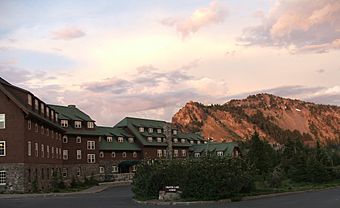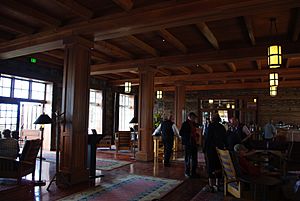Crater Lake Lodge facts for kids
Quick facts for kids |
|
|
Crater Lake Lodge
|
|
|
U.S. Historic district
Contributing property |
|

The lodge in 2007
|
|
| Location | Crater Lake National Park, Oregon |
|---|---|
| Nearest city | Fort Klamath, Oregon |
| Built | 1915 |
| Built by | Crater Lake Co. |
| Architect | R.N. Hockenberry & Co. |
| Architectural style | National Park Service rustic |
| Part of | Rim Village Historic District (ID97001155) |
| NRHP reference No. | 81000096 |
| Added to NRHP | May 5, 1981 |
The Crater Lake Lodge is a special hotel built in 1915. It's located in southern Oregon, United States. People stay here when they visit Crater Lake National Park. The lodge sits right on the edge of the Crater Lake volcano, looking down at the beautiful lake about 300 meters (1,000 feet) below.
The National Park Service owns the lodge. It's also listed on the National Register of Historic Places, which means it's an important historical building. Since 2012, it has been part of the Historic Hotels of America program. This means it's recognized as a very old and important hotel.
Contents
Discovering Crater Lake
Crater Lake was formed about 7,700 years ago. A huge volcano called Mount Mazama erupted and then collapsed. This created a giant bowl, or caldera. Over thousands of years, rain filled this bowl, forming the deep blue lake we see today.
The Klamath Indians respected Crater Lake for its amazing blue waters. In 1853, some gold miners found the lake. They called it Deep Blue Lake. But because it was so high up in the Cascade Range, people soon forgot about it.
Measuring the Lake's Depth
In 1886, Captain Clarence Dutton led a team to Crater Lake. They were part of the United States Geological Survey. Dutton's team brought a heavy survey boat, the Cleetwood, up the mountain. They lowered it 600 meters (2,000 feet) into the lake.
From the boat, Dutton used piano wire to measure the lake's depth. He took 168 measurements. His team found the lake was about 608 meters (1,996 feet) deep. This was very close to modern measurements from 1959. Today, we know the deepest point is 589 meters (1,932 feet).
A National Park is Born
William Gladstone Steel joined Dutton's group in 1886. He named many famous spots around the lake. These include Wizard Island, Llao Rock, and Skell Head. Steel also helped with lake surveys. These surveys showed how unique Crater Lake was.
After his trip, Steel worked hard to make Crater Lake a national park. On May 22, 1902, President Theodore Roosevelt signed a bill. This made Crater Lake the sixth national park in the United States. Steel was also the first person to suggest building a lodge for visitors.
Building the Lodge
In 1909, William Gladstone Steel finally convinced Alfred Parkhurst, a builder from Portland, to construct a lodge. It would be built right on the rim of Crater Lake.
Building the lodge was very difficult. Crater Lake gets a lot of snow, about 13.5 meters (533 inches) each winter. This meant the lodge had to be super strong to hold up all that snow.
Neither Parkhurst nor the architects had built in such a harsh place before. Also, building materials had to be trucked in on bad park roads. The construction season was only three months long in the summer. These challenges made building slow and expensive.
To save money, Parkhurst kept the design simple. The outside was covered in tar-paper. The inside walls used a thin cardboard-like material. The lodge didn't have private bathrooms. The only electricity came from a small generator.
Early Years of the Lodge
When Crater Lake Lodge opened in 1915, many people came to visit. Even without many fancy features, the amazing views of Crater Lake and the mountains kept visitors coming.
In 1922, the lodge started a two-year upgrade. They added more guest rooms and private bathrooms in a new part of the building. But they ran out of money, so many new rooms were not finished.
During the Great Depression, fewer people visited the park. The lodge struggled financially and couldn't afford many repairs. However, the guest rooms on the second and third floors were finally finished in the mid-1930s.
Improving the Surroundings
Over time, cars had damaged the plants around the lodge. In the 1930s, the Civilian Conservation Corps (CCC) helped. They built Rim Village next to the lodge. They also planted hundreds of native trees and bushes around the lodge. This helped the building blend into its natural surroundings.
The National Park Service also paved the parking areas and walkways. This greatly reduced dust and dirt around the lodge.
During World War II, Crater Lake National Park and the lodge were closed. After the war, many more tourists came. The National Park Service kept asking the lodge operators to improve the building. But only basic repairs and fire safety updates were done. Eventually, cables were needed to keep the walls from bowing outwards.
Lodge Under Park Service Care
In 1967, the National Park Service bought the Crater Lake Lodge. In 1981, the lodge was listed on the National Register of Historic Places. This recognized its historical importance.
However, the building kept getting worse because there wasn't enough money for repairs. Even though it was historic, the National Park Service thought it was too expensive to fix. They planned to tear it down. But the public disagreed, and the decision was changed.
In 1988, the National Park Service decided to rebuild the lodge. This was part of a bigger plan to improve Rim Village.
A Major Renovation
In the spring of 1989, engineers found that the lodge's main hall was unsafe. It was so weak they feared it might collapse. This forced the National Park Service to close the lodge for a big renovation.
After two years of planning, construction began in 1991. Some original parts of the building were saved. But most of the old building was too damaged to reuse. The main hall was carefully taken apart. The rest of the building was gutted.
Workers installed a new steel support structure. They added modern plumbing and fire safety systems. The guest rooms were updated to modern hotel standards. The renovation finished in the fall of 1994. It cost about $15 million.
On May 20, 1995, Crater Lake Lodge reopened to the public. By 2007, the main hall was fully restored. The dining room, with its lake views, was open. An exhibit room in the lobby shared the history of the lodge, Crater Lake, and the park. The lodge then had 71 rooms.
Today, the lodge is operated by Aramark, which took over in 2018. Since 2012, it has been a proud member of Historic Hotels of America.
See also
 In Spanish: Albergue del Lago del Cráter para niños
In Spanish: Albergue del Lago del Cráter para niños




